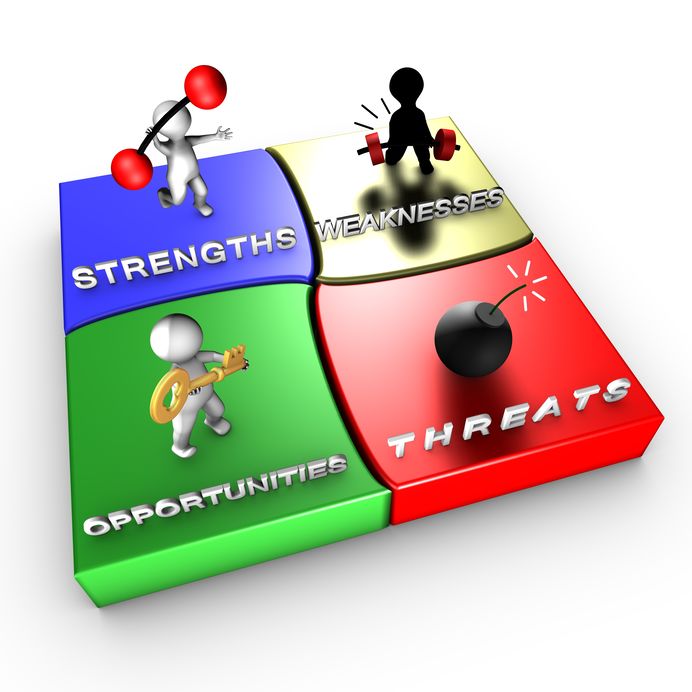SWOT
SWOT compares your organization's capabilities with those of the external environment.

Uses of the method
- Aids strategic thinking and decisioning
- Supports individual and group analysis
Benefits
- Fast and cost effective simple analysis
- Facilitates team discussions
- Produces practical ideas for strengthening organizations
Disadvantages
- Can be too simplistic if done superficially
- May miss key emerging issues and weak signals
- May encourage "Group think"
- Does not look at alternatives nor weigh costs and benefit
- Maybe be backward looking
These disadvantages can be overcome if other methods are used in conjunction with SWOT.
Steps to complete
- Agree the objective
- Determine Strengths: list internal attributes that may be positive to your organization achieving a positive future.
- Determine Weaknesses: list internal attributes that may be detrimental to your organization achieving a positive future.
- Determine Opportunities: List external attributes that may be helpful to your organization achieving a positive future.
- Determine Threats: List external attributes that may be detrimental to your organization achieving a positive future.
*Note that Strengths and weaknesses tend to be about the present whereas Opportunities and Threats tend to be about the future - Describe your aspirational future based on your learning above
- Actions: determine how to improve, exploit or mitigate risks and opportunities identified by the SWOT. Do not concentrate on solving current weaknesses and mitigating potential future threats but look for strategies that seriously enhance your strengths and opportunities and at the same time reduce your risks and threats.
- Describe remaining threats that may be detrimental to your organization achieving a positive future and endeavour to reduce these within the framework of your aspirational future and actions above.
- Now determine how you will track progress through measurable results.
- Capture your most exciting idea and biggest fear.
- Determine the fixed elements (almost certain hard trends) that will inform your strategic response: slow-changing phenomena e.g. demographic shifts, constrained situations e.g. resource limits, in the pipeline e.g. aging of baby boomers, inevitable collisions e.g. climate change arguments.
- Capture critical uncertainties i.e. variables, soft trends and potential surprises. Both these and the fixed elements will be key to creating scenarios and examining potential future paradigm shifts.
- Capture unique insight into new ways of seeing that can be utilized by the organization.
- State alternative hypotheses drawn with different assumptions and judgments.
- Consider what factors would likely change your mind through receipt of new information.
- Determine which factors could surprise and alter your judgment and the direction of the outcome.
- What conclusions can we draw from the exercise(s)?
- How might the future be different?
- How does A affect B?
- What is likely to remain the same or change significantly?
- What are the likely outcomes?
- What and who will likely shape our future?
- Where could we be most affected by change?
- What might we do about it?
- What don't we know that we need to know?
- What should we do now, today?
- Why do we care?
- When should we aim to meet on this?
- Next steps could include a further round of iteration, a recommendation on how to get the answers, use of other methods such as 'Brainstorm' to create more vantage points on the issue or the development of an action plan to close gaps.
Collaboration
This method and your response can be shared with other members or kept private using the 'Privacy' field and through the 'Tag', 'Report' and 'Forum' functionalities. Use 'Tag' and/or 'Report' to aggregate your analyzes, or add a 'Forum' to ask others where they agree/disagree and encourage them to make their own analysis from their unique vantage point.
Click the 'Invite tab to send invitations to other members or non-members (colleagues, external experts etc.) to ask for their input. You can whether or not you want anonymous responses. These can be viewed and exported within the Responses tab.
Further reference
- Structured Analytic Techniques, Heuer & Pherson, CQ Press 2010 http://www.amazon.com/Structured-Analytic-Techniques-Intelligence-Analysis/dp/1608710181
- SWOT Analysis - Mycoted
- SWOT Analysis - Wikipedia
- SOAR: Jackie Stavros and Gina Hinrichs, AI Practitioner, 2007
- SWOT Analysis: MindTools
- swot analysis: BusinessBalls
History
Strategic SWOT analysis was developed in the 1960's and 70's and is generally recognized as the brain child of Albert S. Humphries who was then at SRI (Stanford Research Institute).
It has been suggested that SOAR (Strengths,Opportunities. Aspirations and Results is a better method. We have incorporated both into the SWOT analysis presented here.
Contact us
Even with all the advice and tools we have provided here starting a foresight project from scratch can be a daunting prospect to a beginner. Let us know if you need help with this method or want a group facilitation exercise or full project or program carrying out by us. We promise to leave behind more internal knowledgeable people who can expand your initiative for better organizational performance.
Contact us today for a free discussion on your needs.
Are there other enhancements or new methods you would like to see here? Let us know and we will do our best to respond with a solution quickly.
Copyright
Some rights reserved. This particular part of the website is licensed under a Creative Commons License.